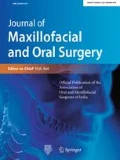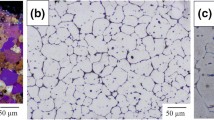Abstract
Background
A variety of materials have been used for bone augmentation, distraction osteotomy, and in post-cancer patients following tumor removal. However, a temporary metal implant that would resorb after successful treatment is a new concept. Magnesium was suggested as a suitable material for these purposes because it is biocompatible, has better mechanical properties than titanium, and stimulates new bone formation. This study evaluates histological appearance of magnesium-based implants and the surrounding bone.
Materials and Methods
Three magnesium-based biomaterials were tested in a rabbit bone defect model: magnesium–hydroxyapatite (Mg–HA), W4 (96 % magnesium, 4 % yttrium), and pure magnesium (pure Mg). Animals were sacrificed after 6 and 12 weeks and the samples were analyzed histologically and histomorphometrically.
Results
Mg–HA had the highest mean amount of tartrate-resistant acid phosphatase (TRAP) positive cells at the implantation site of all groups. It had shown the fastest degradation rate already at 6 weeks but the least amount of new bone formation. New bone was seen forming in direct contact with pure Mg and W4. The mean gas volume was highest in W4 compared to pure Mg and Mg–HA but this difference was not statistically significant. W4 had the lowest mean number of TRAP-positive cells of all materials.
Conclusion
Pure Mg and W4 were shown to be the most promising materials in this study in respect to the bone response to the implant material. They could be used for screws and plates in bone augmentation procedures.






Similar content being viewed by others
References
Quereshy FA, Dhaliwal HS, El SA, Horan MP, Dhaliwal SS (2010) Resorbable screw fixation for cortical onlay bone grafting: a pilot study with preliminary results. J Oral Maxillofac Surg 68(10):2497–2502
Iizuka T, Mikkonen P, Paukku P, Lindqvist C (1991) Reconstruction of orbital floor with polydioxanone plate. Int J Oral Maxillofac Surg 20(2):83–87
Bergsma EJ, Rozema FR, Bos RR, de Bruijn WC (1993) Foreign body reactions to resorbable poly (l-lactide) bone plates and screws used for fixation of unstable zygomatic fractures. J Oral Maxillofac Surg 51(6):666–670
Quereshy FA, Goldstein JA, Goldberg JS, Beg Z (2000) The efficacy of bioresorbable fixation in the repair of mandibular fractures: an animal study. J Oral Maxillofac Surg 58(11):1263–1269
Edwards RC, Kiely KD, Eppley BL (2001) Fixation of bimaxillary osteotomies with resorbable plates and screws: experience in 20 consecutive cases. J Oral Maxillofac Surg 59(3):271–276
Goyer RA, Clarkson TW (2001) Toxicity of metals. In: Klaassen CD (ed) Casarett and Doull’s toxicology: the basic science of poisons. McGraw-Hill Book Company Inc, USA, pp 811–868
Institute of Medicine Standing Committee on the Scientific Evaluation of Dietary Reference Intakes (1997) Dietary reference intakes for calcium, phosphorous, magnesium, vitamin D, and fluoride. National Academy Press, Washington, DC, pp 20–30
Li Z, Gu X, Lou S, Zheng Y (2008) The development of binary Mg–Ca alloys for use as biodegradable materials within bone. Biomaterials 29(10):1329–1344
Xu L, Yu G, Zhang E, Pan F, Yang K (2007) In vivo corrosion behavior of Mg–Mn–Zn alloy for bone implant application. J Biomed Mater Res A 83(3):703–711
Witte F, Kaese V, Haferkamp H, Switzer E, Meyer-Lindenberg A, Wirth CJ, Windhagen H (2005) In vivo corrosion of four magnesium alloys and the associated bone response. Biomaterials 26(17):3557–3563
Staiger MP, Pietak AM, Huadmai J, Dias G (2006) Magnesium and its alloys as orthopedic biomaterials: a review. Biomaterials 27:1728–1734
Witte F, Hort N, Vogt C, Cohen S, Kainer KU, Willumeit R, Feyerabend F (2008) Degradable biomaterials based on magnesium corrosion. Curr Opin Solid State Mater Sci 12:63–72
Shaw BA (2003) Corrosion resistance of magnesium alloys. In: Stephen D (ed) ASM handbook, vol 13a, Corrosion: fundamentals, testing and protection. ASM International, UK, pp 692–696
He W, Zhang E, Yang K (2010) Effect of Y on the bio-corrosion behavior of extruded Mg–Zn–Mn alloy in Hank’s solution. Mater Sci Eng, C 3(1):167–174
Reardon KA, McIntosh AF, Shilling AT, Hagspiel KD, Al-Osaimi A, Berg C, Caldwell SH, Northup PG, Angle F, Mulder R, Rich TA (2009) Treatment of primary liver tumors with yttrium-90 microspheres (TheraSphere) in high risk patients: analysis of survival and toxicities. Technol Cancer Res Treat 8(1):71–77
Sartori M, Giavaresi G, Tschon M, Martini L, Dolcini L, Fiorini M, Pressato D, Fini M (2014) Long-term in vivo experimental investigations on magnesium doped hydroxyapatite bone substitutes. J Mater Sci Mater Med 25(6):1495–1504
Ratna SB, Sampath KTS, Chakkingal U, Nandakumar V, Doble M (2014) Nano-hydroxyapatite reinforced AZ31 magnesium alloy by friction stir processing: a solid state processing for biodegradable metal matrix composites. J Mater Sci Mater Med 25(4):975–988
Witte F, Feyerabend F, Maier P, Fischer J, Störmer M, Blawert C, Dietzel W, Hort N (2007) Biodegradable magnesium–hydroxyapatite metal matrix composites. Biomaterials 28(13):2163–2174
Schaffler MB, Kennedy OD (2012) Osteocyte signaling in bone. Curr Osteoporos Rep 10(2):118–125
Frost HM (1994) Wolff’s Law and bone’s structural adaptations to mechanical usage: an overview for clinicians. Angle Orthod 64(3):175–188
Halleen JM, Tiitinen SL, Ylipahkala H, Fagerlund KM, Väänänen HK (2006) Tartrate-resistant acid phosphatase 5b (TRACP 5b) as a marker of bone resorption. Clin Lab 52(9–10):499–509
Noordin Shahryar, Masri Bassam (2012) Periprosthetic osteolysis: genetics, mechanisms and potential therapeutic interventions. Can J Surg 55(6):408–417
Acknowledgments
The authors would like to sincerely thank Ida Oberst, Iris Schütz and Rainer Braun from the Laboratory for Experimental Trauma Surgery, Justus-Liebig University Giessen, Germany, for their technical assistance.
Conflict of interests
The authors would like to declare no conflict of interests involved during conduction and preparation of this publication.
Author information
Authors and Affiliations
Corresponding author
Additional information
Olga Charyeva and Ulrich Thormann have contributed equally to the paper.
Rights and permissions
About this article
Cite this article
Charyeva, O., Thormann, U., Lips, K.S. et al. Histological Comparison of New Biodegradable Magnesium-Based Implants for Maxillofacial Applications. J. Maxillofac. Oral Surg. 14, 637–645 (2015). https://doi.org/10.1007/s12663-015-0743-z
Received:
Accepted:
Published:
Issue Date:
DOI: https://doi.org/10.1007/s12663-015-0743-z




